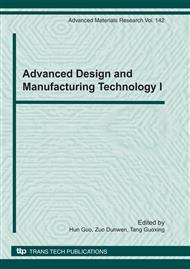p.204
p.209
p.214
p.219
p.223
p.228
p.233
p.238
p.243
Material Removal for Modal Effect on Impeller Blades by Finite Element Analysis
Abstract:
In order to articulate the modal change in the whole processing blades, take the finite element method to establish the simulation model of blades and blank remains, and then get the results of blade model with material removal. According to the blades processed vibration characteristics, to perform an experiment on the six different removal blades. The results show that material removal has a great effect on the modal frequency in the processing of blades, which is increasing constantly. The first-order frequency and the second-order frequency in material removal that are about 12 mm and 7 mm don’t reach a maximum and then show a decreasing trend until the completion of processing. Effectiveness of experimental results is verified since simulation results are well consistent with experimental results, which offers a reference for choosing the parameters of blades process and studying three-dimensional vibration mechanism.
Info:
Periodical:
Pages:
223-227
Citation:
Online since:
October 2010
Authors:
Keywords:
Price:
Сopyright:
© 2011 Trans Tech Publications Ltd. All Rights Reserved
Share:
Citation:


